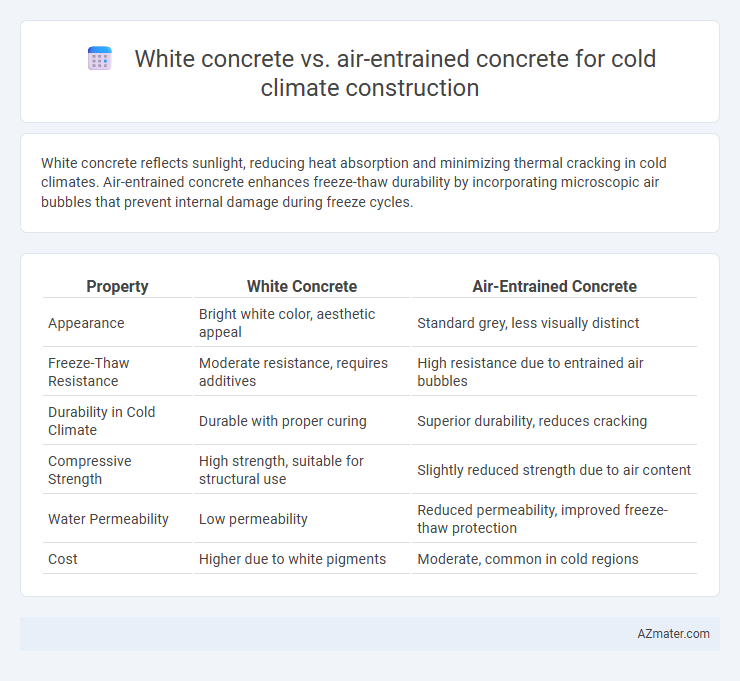White concrete reflects sunlight, reducing heat absorption and minimizing thermal cracking in cold climates. Air-entrained concrete enhances freeze-thaw durability by incorporating microscopic air bubbles that prevent internal damage during freeze cycles.
Table of Comparison
| Property | White Concrete | Air-Entrained Concrete |
|---|---|---|
| Appearance | Bright white color, aesthetic appeal | Standard grey, less visually distinct |
| Freeze-Thaw Resistance | Moderate resistance, requires additives | High resistance due to entrained air bubbles |
| Durability in Cold Climate | Durable with proper curing | Superior durability, reduces cracking |
| Compressive Strength | High strength, suitable for structural use | Slightly reduced strength due to air content |
| Water Permeability | Low permeability | Reduced permeability, improved freeze-thaw protection |
| Cost | Higher due to white pigments | Moderate, common in cold regions |
Introduction to Concrete Choices for Cold Climates
White concrete offers enhanced reflectivity and aesthetic appeal but lacks the frost resistance inherent in air-entrained concrete, which contains microscopic air bubbles that improve durability in freeze-thaw conditions. Air-entrained concrete is specifically engineered to resist cracking caused by the expansion of water upon freezing, making it the preferred choice in cold climate construction. Selecting the appropriate concrete type depends on balancing visual requirements with the need for structural integrity and longevity in low-temperature environments.
Defining White Concrete: Properties and Applications
White concrete, characterized by its use of white Portland cement and light-colored aggregates, offers high reflectivity and aesthetic appeal, making it ideal for architectural applications and environments requiring enhanced brightness. Its lower thermal mass compared to traditional gray concrete can influence heat retention, posing specific considerations for cold climate construction where insulation and warmth are critical. White concrete's durability and resistance to chemical attacks make it suitable for exterior surfaces exposed to harsh winter conditions, ensuring long-term structural integrity.
Understanding Air-Entrained Concrete: Key Features
Air-entrained concrete contains microscopic air bubbles intentionally introduced during mixing to improve freeze-thaw durability in cold climates. These air pockets provide space for water to expand when it freezes, reducing internal pressure and preventing cracking. Unlike white concrete, which focuses on aesthetic and reflective properties, air-entrained concrete prioritizes structural resilience against harsh freezing conditions.
Thermal Performance in Cold Conditions
White concrete exhibits higher solar reflectance and lower thermal conductivity than air-entrained concrete, making it effective in minimizing heat loss in cold climates. Air-entrained concrete incorporates microscopic air bubbles that improve freeze-thaw resistance but can marginally reduce overall thermal insulation capacity. Selecting white concrete enhances thermal retention and energy efficiency in cold weather construction, while air-entrained concrete provides durability against cold climate stresses.
Resistance to Freeze-Thaw Cycles
White concrete and air-entrained concrete both enhance resistance to freeze-thaw cycles in cold climate construction by reducing internal stress from moisture expansion. Air-entrained concrete contains microscopic air bubbles that provide space for water to expand when frozen, significantly improving durability and minimizing cracking. White concrete, while aesthetically beneficial and reflective for thermal regulation, offers less inherent freeze-thaw resistance compared to the engineered air void system in air-entrained concrete.
Structural Durability and Longevity Comparisons
White concrete offers enhanced aesthetic appeal and high reflectivity, reducing thermal stress in cold climates, but lacks the micro-air void system essential for freeze-thaw durability. Air-entrained concrete contains millions of microscopic air bubbles that provide critical freeze-thaw resistance, preventing internal cracking and spalling, which significantly improves structural durability and extends service life in cold weather conditions. Studies show air-entrained concrete outperforms white concrete in longevity due to its superior ability to withstand cyclic freezing and thawing without compromising strength.
Workability and Placement in Low Temperatures
White concrete offers improved visibility for quality control during placement in cold climates, but its workability can be challenging due to lower cement content and higher water demand. Air-entrained concrete enhances freeze-thaw resistance by incorporating microscopic air bubbles, which also improve workability and ease of placement in low temperatures by maintaining slump and reducing the risk of segregation. Selecting air-entrained concrete is generally advantageous for cold climate construction, as it balances durability and workability under harsh conditions.
Aesthetic and Reflective Qualities in Snowy Environments
White concrete offers superior aesthetic appeal in snowy environments due to its bright, clean appearance that blends seamlessly with snow, enhancing the visual harmony of cold climate structures. Its high reflectivity reduces heat absorption, which helps maintain consistent surface temperatures and minimizes ice formation, contributing to safer, more durable surfaces. In contrast, air-entrained concrete focuses on durability and freeze-thaw resistance but lacks the pronounced reflective and aesthetic advantages of white concrete in winter landscapes.
Cost Analysis: Material, Labor, and Maintenance
White concrete typically incurs higher material costs due to the use of specialized white cement and aggregates, whereas air-entrained concrete remains more economical with standard Portland cement and added air-entraining agents. Labor expenses for both types are comparable, but maintenance costs diverge as air-entrained concrete offers superior freeze-thaw durability, reducing repair frequency in cold climates. Long-term lifecycle cost analysis favors air-entrained concrete for cold climate construction because of its enhanced resistance to scaling and cracking, lowering overall maintenance expenditures.
Recommended Uses and Best Practices for Cold Climate Construction
White concrete excels in decorative applications and environments demanding high reflectivity, while air-entrained concrete is specifically recommended for cold climate construction due to its enhanced freeze-thaw durability and resistance to scaling caused by deicing salts. Best practices for cold climate use of air-entrained concrete include maintaining an optimal air content of 6-8%, proper curing methods to prevent early frost damage, and using supplementary cementitious materials to improve long-term durability. Employing air-entrained concrete ensures structural integrity and longevity in regions with frequent freeze-thaw cycles, whereas white concrete is best reserved for aesthetic projects with less exposure to harsh freeze-thaw conditions.

Infographic: White concrete vs Air-entrained concrete for Cold climate construction
 azmater.com
azmater.com